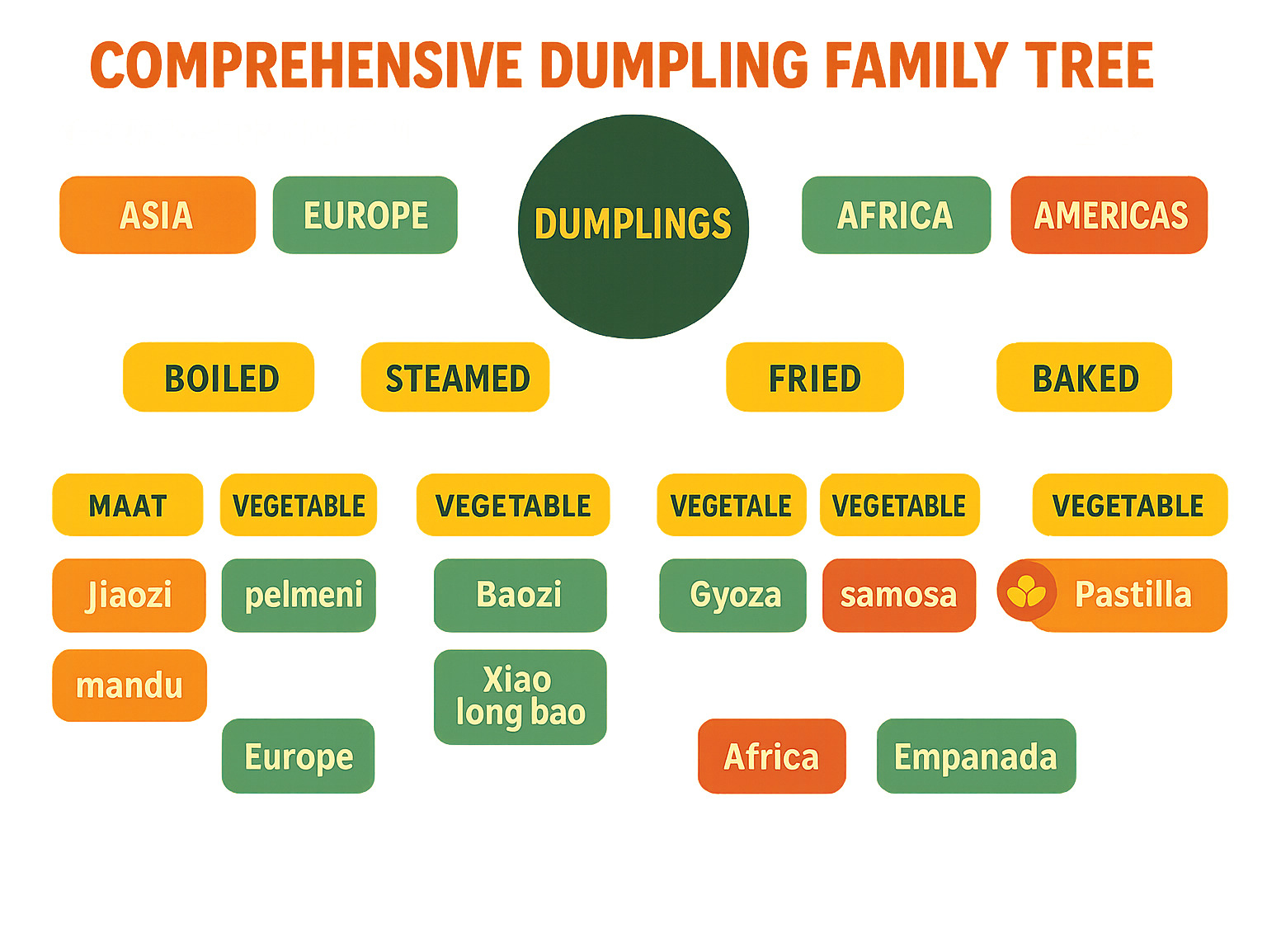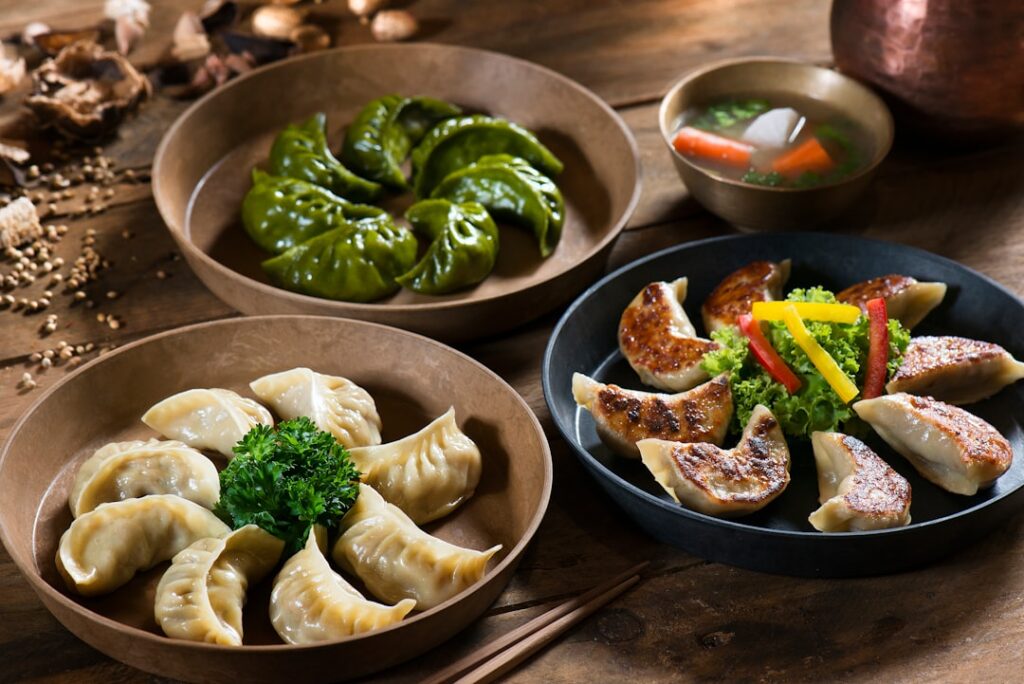Why Dumplings Are the World’s Most Beloved Comfort Food
Dumplings are small pieces of cooked dough that can be boiled, steamed, fried, or baked – and they exist in nearly every cuisine on Earth. Whether filled with savory meat and vegetables or sweet ingredients, these humble pockets of dough represent one of humanity’s most universal comfort foods.
Quick Dumpling Facts:
- Definition: Small masses of dough, often wrapped around fillings
- Cooking methods: Boiling, steaming, frying, or baking
- Global varieties: Chinese jiaozi, Polish pierogi, Italian ravioli, Japanese gyoza
- Cultural significance: Symbol of prosperity, family gatherings, and celebration
- Main ingredients: Flour-based dough with meat, vegetable, or sweet fillings
From the busy night markets of Asia to cozy European kitchens, dumplings tell stories of migration, adaptation, and shared human experiences. The earliest dumplings trace back over 1,800 years to China’s Eastern Han Dynasty, where legend credits physician Zhang Zhongjing with creating ear-shaped dumplings filled with medicinal herbs to treat frostbite.
Whether you’re planning your next culinary trip or want to master the art of dumpling-making at home, these versatile comfort foods offer endless possibilities for exploration and creativity.

Find more about dumplings:
Why We Love Dumplings
There’s something magical about dumplings that goes far beyond their simple ingredients. These little pockets of joy have captured hearts across cultures for centuries.
The origin stories alone are captivating. Take the Chinese legend of Zhang Zhongjing, a physician who created ear-shaped dumplings filled with warming herbs to help villagers suffering from frostbite during a harsh winter. Or consider Polish tales of pierogi sustaining entire communities through difficult times, with recipes passed down like precious family heirlooms.
What makes dumplings so universally beloved is their deep symbolism. In Chinese culture, jiaozi are shaped like ancient gold ingots, making them powerful symbols of prosperity and good fortune. The act of making them brings families together – multiple generations gathering around kitchen tables, sharing stories while their hands work in rhythm, folding and pleating.
This unity and togetherness isn’t unique to one culture. Italian families bond over Sunday gnocchi-making, while Polish grandmothers teach their grandchildren the art of pierogi pleating.
Perhaps most remarkably, dumplings showcase incredible adaptability. When ingredients were scarce, cooks found creative substitutions. When families moved to new countries, they adapted their beloved recipes to local tastes and available ingredients.
But let’s be honest – there’s also pure nostalgia at play. Who doesn’t have a memory of comfort found in a warm bowl of chicken and dumplings on a sick day? These foods connect us to our childhoods, our heritage, and our sense of home.
How to Use This Guide
Think of this guide as your dumpling passport – ready to take you on a delicious journey whether you’re standing in your own kitchen or exploring the vibrant food scenes around the world.
Cook at home with confidence using our step-by-step recipes that work for complete beginners and seasoned home cooks alike. We’ll walk you through everything from mixing the perfect dough to mastering those tricky pleating techniques. When things go wrong (and they sometimes do!), our troubleshooting tips will help you rescue even the most stubborn dumplings.
Travel planning becomes so much more exciting when you know what culinary treasures to hunt for. We’ll help you identify must-try regional specialties – from steaming bamboo baskets in busy night markets to hidden dumpling gems right here in New York City. You’ll know exactly what to order and why it’s special before you even sit down.
Flavor pairings can make or break your dumpling experience. We’ll teach you how different dough types complement various fillings, which cooking methods bring out the best textures, and how to create dipping sauces that make each bite sing. Whether you’re mixing traditional combinations or experimenting with fusion flavors, you’ll understand the science behind what makes dumplings taste amazing.
This isn’t just a cookbook or travel guide – it’s your companion for finding why these little pockets of joy have captured hearts (and stomachs) across every continent.
What Are Dumplings? A Global Definition & Evolution
The story of dumplings begins with a simple yet brilliant idea: wrap something delicious in dough and cook it. But like all great culinary concepts, this one has traveled the world and picked up countless variations along the way.
The word “dumpling” itself has humble English roots, first appearing in 17th-century cookbooks to describe plain lumps of dough that were simmered or steamed in broths. The earliest archaeological evidence points to Central Asia around 499–640 CE, though Chinese legends credit physician Zhang Zhongjing with creating the first filled dumplings during the Eastern Han Dynasty.
What makes a dumpling a dumpling? At its heart, a dumpling is simply cooked dough—but that dough can be made from wheat, potato, rice, or even cassava. It might be filled with savory pork and cabbage, sweet red bean paste, or creamy cheese. Or it could be unfilled, like the drop dumplings that float in Southern chicken and dumplings.
The magic happens in how you cook them. Boiling creates tender, silky textures. Steaming keeps things light and delicate. Frying adds that irresistible golden crunch. Baking brings out deeper, more complex flavors.
Comparison Table: Dough Bases & Textures
| Dough Base | Common Varieties | Typical Texture | Cultural Examples |
|---|---|---|---|
| Wheat flour | Jiaozi, Ravioli, Gyoza | Chewy, Tender | China, Italy, Japan |
| Potato | Gnocchi, Kroppkakor | Soft, Fluffy | Italy, Sweden |
| Rice flour | Tangyuan, Har Gow | Silky, Elastic | China, SE Asia |
| Bread/Yeast | Baozi, Dombolo | Fluffy, Spongy | China, South Africa |
| Corn/Cassava | Poutine Râpée, Kenkey | Dense, Moist | Canada, West Africa |
Today’s dumplings represent thousands of years of culinary evolution, migration, and adaptation. They’re proof that the best comfort foods are the ones that travel well—both literally and figuratively.
A World Tour of Dumpling Varieties
Ready to take your taste buds on a global trip? Dumplings appear in nearly every corner of the world, each variety telling its own delicious story of local ingredients, cooking traditions, and cultural celebrations.
Asian Dumplings 101
Asia is the undisputed dumpling capital of the world, where these little pockets of joy have been perfected over thousands of years.
Jiaozi are China’s most famous contribution to the dumpling world. These crescent-shaped beauties, typically filled with pork and cabbage, are essential for Lunar New Year celebrations because their shape resembles ancient gold ingots—perfect for attracting prosperity.
Japan’s gyoza are the crispy-bottomed cousins of Chinese jiaozi. They’re usually pan-fried first to create that perfect golden crust, then steamed to finish cooking. Baozi are those fluffy, cloud-like steamed buns filled with everything from savory pork to sweet red bean paste.
The Himalayas give us momo, Nepal and Tibet’s answer to dumplings, often packed with garlic and warming spices. Korea’s mandu can be steamed, pan-fried, or boiled, with fillings ranging from traditional beef to spicy kimchi.
Don’t miss siu mai, those open-topped steamed dumplings that are dim sum stars, or tangyuan—sweet rice balls filled with black sesame that literally melt in your mouth. Georgia contributes khinkali—those twist-topped, brothy dumplings that require special eating techniques.
European Dumplings 101
Europe’s dumpling traditions range from delicate Italian creations to hearty Germanic comfort food.
Poland’s pierogi are probably Europe’s most famous dumplings. These semi-circular pockets are often filled with mashed potatoes and cheese (pierogi ruskie), though sweet versions with fruit are equally beloved.
Russia gives us pelmeni—small, meat-filled dumplings that are boiled and served simply with sour cream. Italy perfected the art with ravioli and tortellini, while gnocchi are those pillowy potato dumplings perfect with sage butter.
Germany and Austria contribute knödel, substantial bread or potato-based dumplings perfect alongside hearty meat dishes. Sweden’s kroppkakor are potato-based dumplings filled with pork and traditionally served with lingonberry jam.
African & Middle-Eastern Pockets
Africa and the Middle East showcase how dumplings evolve through cultural fusion and local ingredients.
South Africa offers dombolo—yeast-leavened steamed dough balls perfect for soaking up rich stews. The Middle East gives us manti, tiny meat-filled dumplings topped with yogurt and spicy chili butter.
The Levant region treasures shishbarak, lamb dumplings simmered in tangy yogurt sauce. These regions show how dumplings adapt to local spices and cultural preferences.
American & Latin Comforts
The Americas have acceptd dumplings with enthusiasm, creating both festival foods and weeknight comfort classics.
The American South perfected chicken-and-dumplings, where fluffy biscuit-like dough is dropped directly into bubbling chicken stew. Latin America contributes empanadas, those golden turnover-style dumplings that can be baked or fried.
Brazil’s pastel are crispy, fried pockets stuffed with cheese or seasoned ground meat, while Canada’s poutine râpée represents the unique Québécois tradition of potato dumplings with salted pork centers.
Mastering Dough, Fillings & Cooking Techniques
Making dumplings at home might seem intimidating at first, but once you understand the basics, it becomes an incredibly rewarding experience. The secret lies in mastering three key elements: creating the perfect dough, crafting flavorful fillings, and choosing the right cooking method.
Think of dumpling-making as a conversation between your hands and the ingredients. The dough needs to be hand-kneaded until it develops just enough gluten to hold together without becoming tough. Your wrappers should be rolled thin enough to cook through but thick enough to contain all that delicious filling.
One game-changing technique every home cook should know is the pan-steam method for potstickers. You get crispy bottoms and tender tops in one go. Plus, flash freezing your finished dumplings means you can always have a batch ready for comfort food emergencies.
The science behind perfect dumplings is fascinating. Understanding starch gelatinization helps explain why some doughs turn silky while others become chewy. For hands-on learning, Craftsy’s Asian Dumplings class offers excellent step-by-step guidance.
Dough Basics
The foundation of any great dumpling starts with understanding your dough. All-purpose flour works beautifully for most recipes, but don’t be afraid to experiment. Potato-based doughs create those pillowy Italian gnocchi, while rice flour gives you the translucent, silky wrappers you see in dim sum restaurants.
Hydration is where many home cooks stumble. Too little water and your dough cracks when you try to shape it. Too much and it becomes sticky and impossible to work with. The sweet spot is usually around 50-60% water to flour by weight.
For gluten-free dumpling lovers, rice flour blends work wonderfully, especially when you add a pinch of xanthan gum for that stretchy quality.

Flavor-Packed Fillings
Great fillings balance flavor, texture, and moisture. The classic pork and cabbage combination works so well because the cabbage adds sweetness and crunch while the pork provides richness. The key? Always salt your cabbage and squeeze out the excess water—nobody wants soggy dumplings.
Potato and cheese fillings, like those in pierogi ruskie, need that perfect creamy consistency. Sweet red bean paste brings an entirely different experience—earthy, subtly sweet, and perfect for dessert dumplings.
Vegan mushroom fillings have exploded in popularity. Shiitake mushrooms provide incredible umami depth, while glass noodles or crumbled tofu add satisfying texture. Seasonings make all the difference: fresh ginger and garlic for Asian-style, dill for Eastern European, or a touch of nutmeg for German-inspired varieties.
Cooking Methods Demystified
Each cooking method produces dramatically different textures and flavors. Boiling gives you tender, juicy dumplings that showcase the filling—perfect for pierogi or jiaozi. Steaming creates either fluffy bread-like textures or silky, translucent wrappers.
Pan-frying produces those coveted potstickers with crispy bottoms and tender tops. Start by searing the dumplings in oil, then add water, cover, and let them steam. Deep-frying creates golden, crunchy exteriors, while baking works wonderfully for large batches.
Always check that meat-filled dumplings reach an internal temperature of 165°F (74°C) for food safety.
Troubleshooting Your Dumplings
Tearing dough usually means you didn’t let it rest long enough or you’re overfilling. Soggy centers happen when vegetables release too much moisture during cooking. Pre-salt watery vegetables like cabbage, then squeeze them dry.
If your dumplings are stuck to the pan, you probably didn’t use enough oil or tried to move them too early. Sealing fails are fixable—make sure your wrapper edges are slightly damp, press firmly to remove air bubbles, and crimp with confidence.
Want to experience amazing dumplings made by experts? Check out our guide to street food tours for inspiration on your next culinary trip.
Classic Dumpling Recipes You Can Make at Home
There’s something magical about making dumplings from scratch in your own kitchen. The rhythmic rolling of dough, the careful pleating, and that first perfect bite make all the effort worthwhile. These recipes will guide you through creating restaurant-quality dumplings at home.

The beauty of homemade dumplings lies in their versatility. You can make huge batches for meal prep, experiment with creative fillings, or stick to time-tested classics. Most recipes freeze beautifully, so you’ll always have comfort food ready when you need it most.
Chinese Pork Jiaozi
These crescent-shaped beauties aren’t just delicious—they’re symbols of prosperity and good fortune. Traditional Chinese families believe that eating jiaozi during Lunar New Year brings wealth because their shape resembles ancient gold ingots.
Start by preparing your filling with ground pork, finely chopped Napa cabbage (salted and squeezed completely dry), minced scallions, fresh ginger, soy sauce, and a drizzle of sesame oil. The key to perfect jiaozi is removing every bit of moisture from your cabbage—soggy filling leads to soggy dumplings.
Place just a scant tablespoon of filling in the center of each round wrapper. Lightly dampen the edges with water, fold the wrapper in half, and create beautiful pleats along one side while pressing firmly to seal.
You can boil them for tender results, steam them for silky texture, or try the potsticker method—pan-sear until golden, add water, cover, and steam until cooked through.
Polish Pierogi Ruskie
Despite the name suggesting Russian origins, these beloved dumplings are thoroughly Polish comfort food. The classic filling combines creamy mashed potatoes, tangy farmer’s cheese, and sweet caramelized onions—pure comfort in every bite.
Make your dough with just flour, egg, and water, kneading until smooth and elastic. Roll it thin, cut circles with a glass, then fill each with a generous spoonful of the potato mixture. Fold in half and seal the edges with a fork for that traditional crimped look.
Boil the pierogi until they float, then finish them in a skillet with butter until golden and crispy. Serve with more caramelized onions and sour cream.
Southern Chicken-and-Drop Dumplings
This soul-warming dish proves that not all dumplings need fancy wrappers. These fluffy, biscuit-like dumplings are dropped directly into simmering chicken broth, where they puff up and help thicken the stew.
Mix flour, baking powder, salt, cold butter, and milk until just combined—overmixing creates tough dumplings. Drop spoonfuls of the batter onto your bubbling chicken stew, then simmer uncovered for 10 minutes, followed by 10 minutes covered. Resist the urge to lift the lid during that final steaming phase.
Gluten-Free Potstickers
Rice flour creates surprisingly stretchy, translucent wrappers that rival traditional wheat versions. Sweet rice flour (glutinous rice flour) works especially well for that perfect chewy texture. Try this gluten-free potstickers recipe for detailed wrapper instructions and a delicious tamari-based dipping sauce.
Creative Fusion Bites
Once you’ve mastered the basics, it’s time to get creative. Kimchi dumplings bring Korean heat and tang to traditional Chinese wrappers. Pierogi-wontons stuff classic Polish potato filling into delicate Asian skins. For dessert lovers, chocolate bao features fluffy steamed buns hiding molten chocolate centers.
Want to taste innovative dumplings created by professional chefs? Check out some unique dining spots where creativity meets tradition in the most delicious ways possible.
Dumplings in Festivals, Symbolism & Modern Trends

There’s something magical about watching three generations of a family gathered around a kitchen table, rolling and pleating dumplings together. These moments capture why dumplings are so much more than food—they’re cultural rituals, symbols of hope, and bridges between past and future.
Dumplings & Celebration
Dumplings transform ordinary gatherings into meaningful celebrations. During Lunar New Year, Chinese families make hundreds of jiaozi together, their crescent shapes symbolizing ancient gold ingots and the promise of prosperity. Grandmothers teach children the perfect pleating technique while sharing stories.
At Dragon Boat Festival, families wrap sticky rice dumplings called zongzi in bamboo leaves. In Eastern Europe, Christmas Eve tables overflow with pierogi and tiny uszka floating in clear borscht—each dumpling representing abundance and family unity.
Weddings and special occasions across Central Asia feature towering plates of khinkali and manti. These aren’t just meals; they’re edible prayers for good fortune.
Sustainable & Health-Forward Dumplings
Modern dumpling makers are reimagining these ancient foods for today’s conscious eaters. Local ingredients are taking center stage as chefs swap imported fillings for regionally sourced vegetables and meats.
Upcycled fillings are turning yesterday’s leftovers into today’s delicious dumplings. That Thanksgiving turkey finds new life wrapped in dumpling dough, and last night’s roasted vegetables become tomorrow’s creative filling.
The plant-based protein movement has acceptd dumplings wholeheartedly. Jackfruit, mushroom medleys, and seasoned tofu are creating vegan dumplings so satisfying that even meat-lovers are converted.
Portion control becomes effortless with dumplings—each bite-sized package makes it easy to balance indulgence with nutrition.

Street-Food Renaissance
Dumplings are leading the charge in the global street food revival. Night markets from Taipei to New York City buzz with the sizzle of potstickers hitting hot pans and the steam rising from bamboo baskets.
Food trucks are pushing creative boundaries with fusion dumplings that would make traditionalists smile and scratch their heads simultaneously. Korean-Mexican mandu tacos and Italian-Chinese ravioli wontons prove that good food knows no borders.
Want to dive deeper into this delicious world? A Bali Street Food Tour offers incredible insights into how dumplings and other street foods bring communities together, one bite at a time.
Frequently Asked Questions about Dumplings
Making dumplings at home can feel intimidating at first, but with the right knowledge, you’ll be wrapping like a pro in no time. Let’s tackle the most common questions that come up in dumpling kitchens around the world.
How do I store and reheat dumplings safely?
Fresh dumplings are best enjoyed right away, but refrigerate cooked dumplings in an airtight container for up to three days. For longer storage, freezing is your best friend. Flash freeze uncooked dumplings on a parchment-lined tray first, making sure they don’t touch each other. Once solid, transfer them to freezer bags. Properly frozen dumplings stay good for up to three months.
When reheating, gentle is the way to go. Steam leftover dumplings for a few minutes or microwave them with a damp paper towel on top. For fried dumplings that have lost their crispiness, re-crisp them in a hot pan with a little oil.
What common mistakes should I avoid when making dumplings?
The biggest mistake? Overmixing your dough. Knead just until it comes together, then let it rest. Overworked dough becomes tough and chewy.
Overfilling is another classic error. A scant tablespoon of filling is plenty. Too much filling makes sealing nearly impossible and leads to messy bursts during cooking.
Never lift the lid while your dumplings are steaming or simmering. This releases crucial steam and leads to uneven cooking. Don’t forget to let your dough rest for at least 30 minutes before rolling. Finally, avoid crowding your pan or steamer—dumplings need space to cook evenly.
Are there vegetarian, vegan, or gluten-free dumpling options?
Absolutely! Dumplings are incredibly adaptable to different dietary needs. Many classic fillings are naturally vegetarian—think potato and cheese pierogi, mushroom and cabbage combinations, or sweet red bean paste for dessert dumplings.
Vegan dumplings are just as delicious. Replace meat with seasoned tofu, jackfruit, or a mix of mushrooms and vegetables. Many traditional Asian dumpling fillings are already vegan-friendly.
Gluten-free dumplings require wrapper substitutions, but they’re totally doable. Rice flour creates silky, translucent skins perfect for har gow-style dumplings. Check out this gluten-free potsticker recipe for detailed instructions.
The key is understanding that every dietary restriction is just another creative challenge. Dumplings have been adapted across cultures for centuries—your kitchen experiments are part of that beautiful tradition.
Conclusion
Our journey through dumplings has taken us from ancient Chinese medicine halls to busy New York City dim sum restaurants, from Polish Christmas tables to Korean street food stalls. These humble pockets of dough have proven themselves to be so much more than just food—they’re edible stories that connect us across cultures and generations.
What makes dumplings truly special is how they transform simple ingredients into something magical. Whether you’re carefully pleating jiaozi with your family, rolling gnocchi on a Sunday afternoon, or finding a new fusion creation at a food truck, each dumpling carries the warmth of human creativity and tradition.
The beauty of dumplings lies in their endless possibilities. They adapt to local ingredients, dietary needs, and personal tastes while maintaining their essential comfort-food soul. From gluten-free rice flour wrappers to plant-based fillings, today’s dumpling makers are pushing boundaries while honoring age-old techniques.
These modern-culinary journeys don’t require a passport—though they certainly inspire wanderlust. Every time you master a new pleating technique or experiment with an unexpected filling, you’re participating in a global conversation that spans centuries.
At The Dining Destination, we see dumplings as the perfect one-dish global passport. They invite you to explore, experiment, and connect—whether you’re cooking at home or seeking out authentic experiences in New York City’s vibrant food scene.
Ready to continue your dumpling journey? Find more interesting places to eat and let your taste buds guide your next culinary exploration. After all, dumplings is vast, delicious, and always ready to welcome you home.









1 thought on “The Ultimate Guide to Dumplings: Types, History, and Recipes”
Pingback: A Comprehensive Guide to Chow Mein: History, Varieties & Recipes - The Dining Destination
Comments are closed.